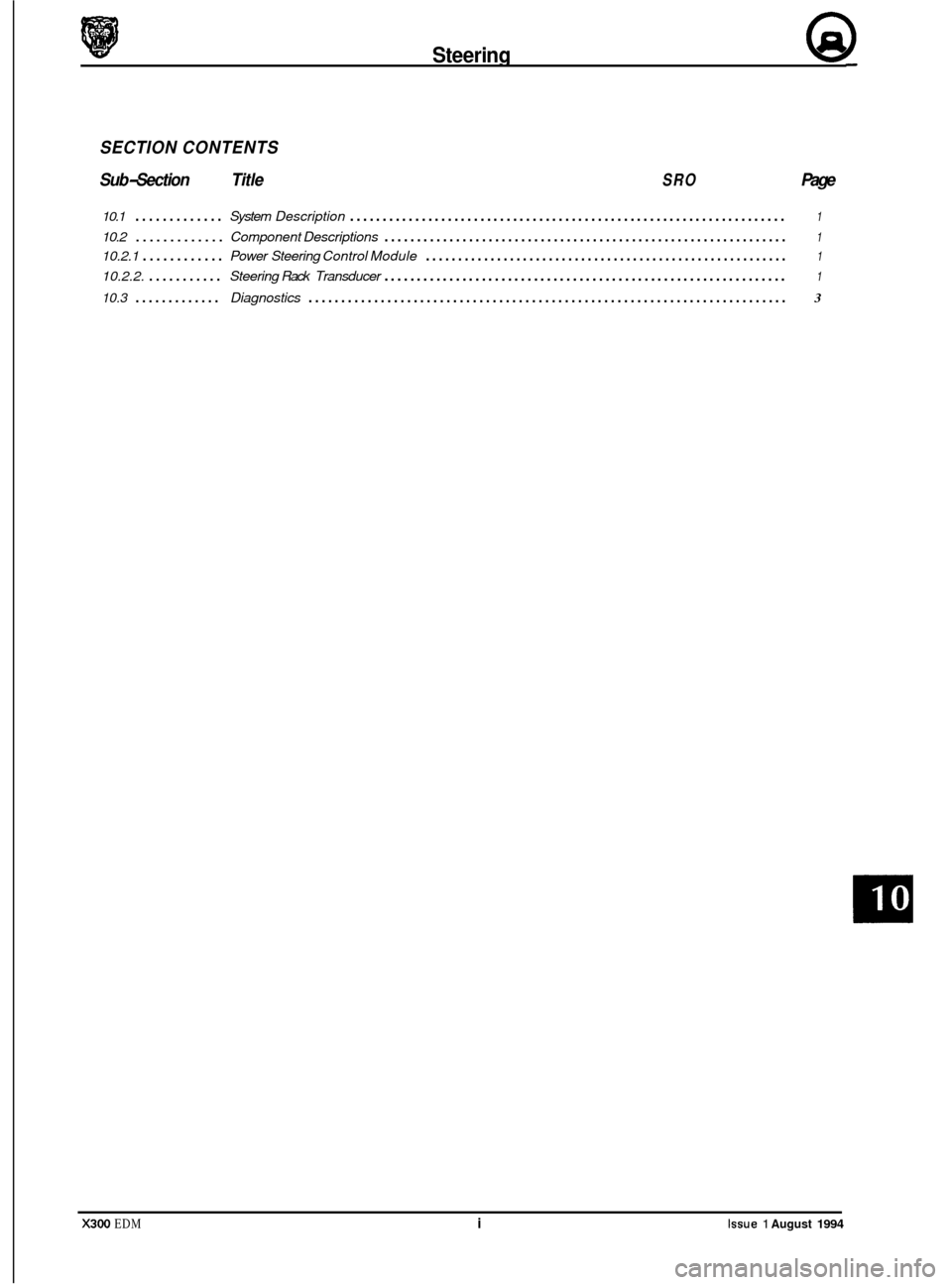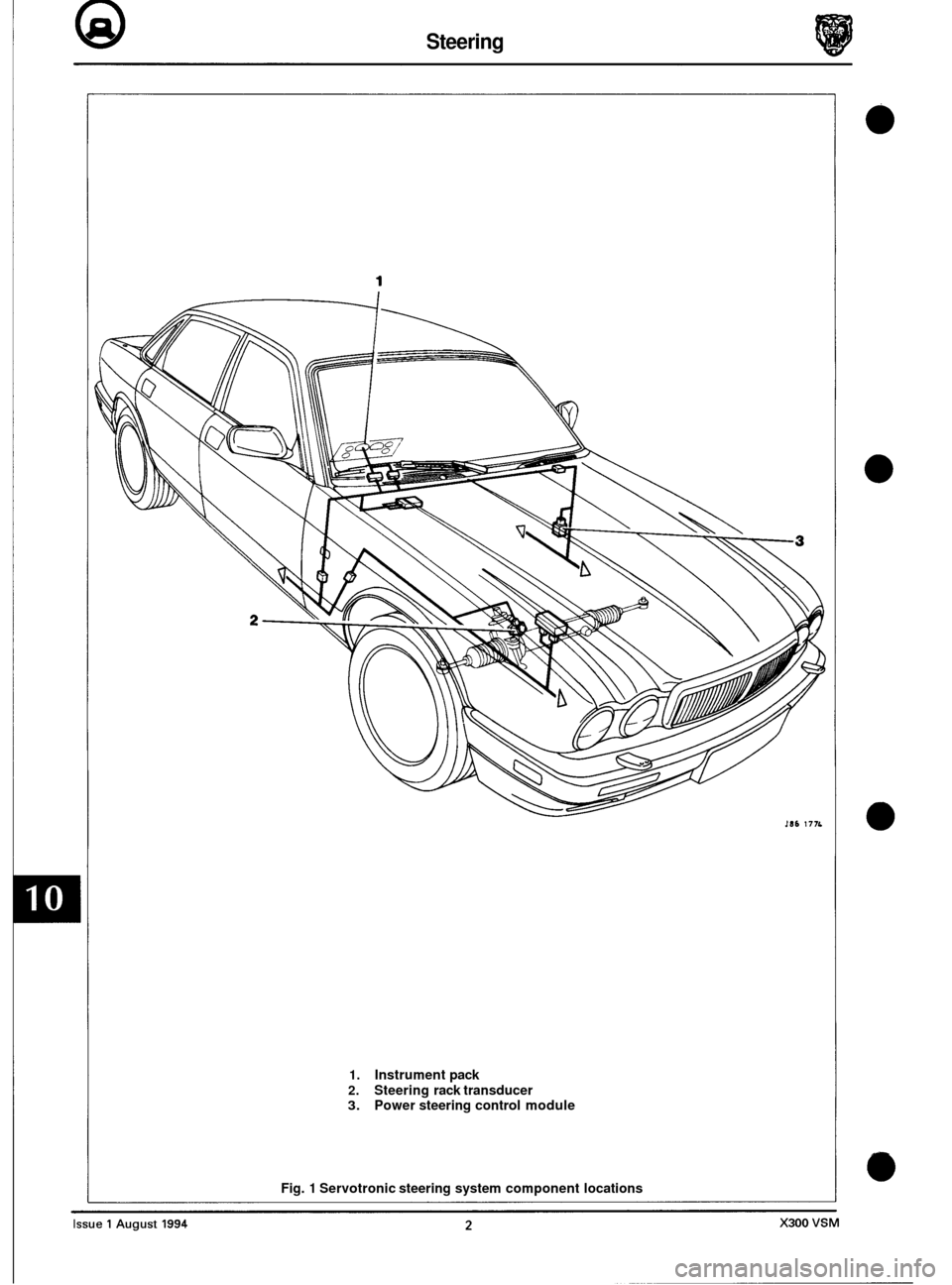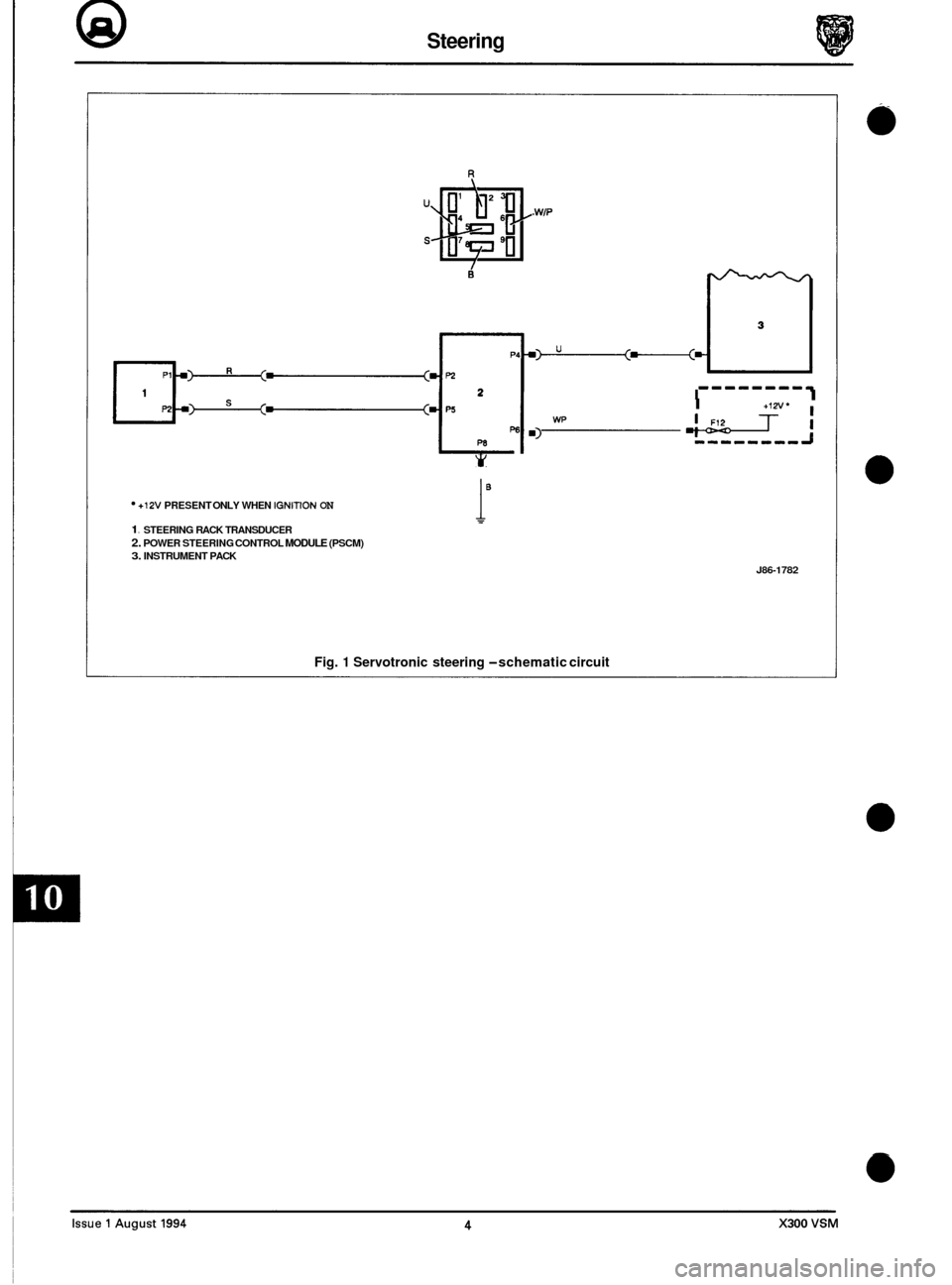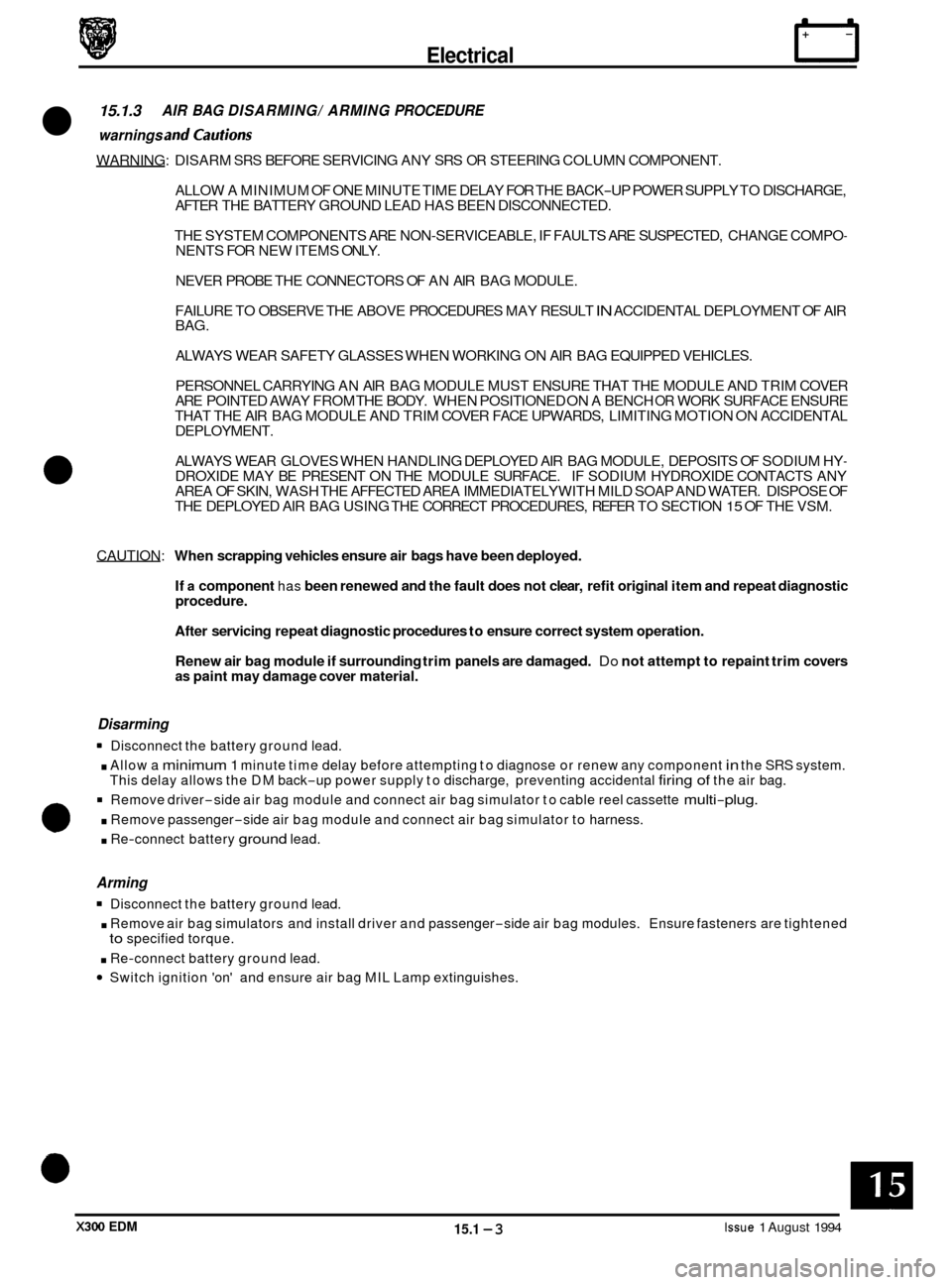1994 JAGUAR XJ6 steering
[x] Cancel search: steeringPage 59 of 327

Steering 69
SECTION CONTENTS
Sub
-Section Title SRO Page
10.1 ............. System Description ................................................................... 1
10.2.1 ............ Power Steering Control Module ........................................................ 1
10.2.2. ........... Steering Rack Transducer .............................................................. 1
10.2 ............. Component Descriptions .............................................................. 1
10.3 ............. Diagnostics ........................................................................\
. 3
X300 EDM i Issue 1 August 1994
Page 61 of 327

Q Steering
I86 177L
1. Instrument pack
2. Steering rack transducer 3. Power steering control module
Fig.
1 Servotronic steering system component locations
Page 62 of 327

Steering @
10.3 DIAGNOSTICS
a Fault: Steering light at all times
Cause: 1. No speed signal
2. Wiring fault
Remedy: 1.
2a.
2b. Check
wiring harness continuity between PSCM pin
V and instrument pack
pin
2.
Check voltage between transducer pin 1 (+ve) and ground, with ignition
ON. If 12V is recorded repair or renew harness.
Check wiring between transducer pin
2 (-ve) and OV. If OV is recorded
repair or renew harness.
Fault: Steering heavy at all times
Cause: 1. Fuse blown
2. Wiring fault
Remedy: 1.
2a.
2b.
2c.
2d Examine
fuse F12 in
RH heelboard fuse-box, if blown determine reason for
failure and renew.
Check wiring harness continuity between fuse F12 in
RH heelboard
fuse
-box and PSCM pin V.
Check wiring harness continuity between PSCM pin W1 and transducer
pin 1.
Check wiring harness continuity between PSCM pin W2 and transducer
pin
2.
Check voltage between transducer pin 2 and ground, with ignition ON. If
12V is recorded repair or renew harness and renew PSCM.
Fault:
Cause:
1. Short circuit
Remedy:
Steering becomes heavy during driving until ignition cycled
la.
1 b.
Check resistance between transducer pins 1 and 2. If a value below 7.5f is
recorded renew transducer.
Check resistance of wiring harness between transducer connections. If
short circuit is recorded renew harness.
Note: Operation ofthe PSCM can bechecked using Jaguar Diagnostic Equipment. Generation of input speed signals
and measurement of the resulting current outputs indicate
if PSCM is faulty.
X300 EDM 3 Issue 1 August 1994
Page 63 of 327

@ Steering
R
. WIP
+ Y
1- -------q I I +I" I
*Ti m) wp I
+12V PRESENT ONLY WHEN IGNITION ON
1. STEERING RACK TRANSDUCER 2. POWER STEERING CONTROL MODULE (PSCM) 3. INSTRUMENT PACK
i"
J86-1782
Fig. 1 Servotronic steering -schematic circuit
Page 98 of 327

Climate Control Systems
14.7.22 BLOWER MOTORS
Disconnect the blower motors (LH & RH) multi-plugs and check motor operation by applying battery voltage (+12V) across pin 5 (+vel and pin 9 (-ve).
Non-functioning of both L H and RH motors *
Cause:
1. Loss of ignition voltage.
Remedy:
1.
2.
*
Examine fuse F12 in RH heelboard fuse-box. If fuse is blown determine reason for failure and renew.
Examine harness wiring from
RH heelboard fuse-box connection CA044/010 to splice CAS53. Repair or renew
wiring as necessary.
This fault will also affect the operation of seat control modules, power steering control module and door mirror
heaters.
Non-functioning of RH blower motor only
Cause:
1. Faulty relay operation.
2. Faulty harness wiring.
Remedy:
1. Ensure 12Vsupply between relay pin 1 and ground.
Ensure continuity between pins 3 and
5 when relay operated.
Ensure relay coil impedance of
7552 to 135Q across pins 1 and 2.
Ensure correct seating of relay on base. Examine pins for damage or deformity.
Check continuity of wiring from fuse F12
(RH heelboard fuse-box) to relay pin 1 and from relay pin 2 to A / CCM
pin 53 (26-way connector).
Check continuity of wiring from fuse
F11 (RH heelboard fuse-box) to relay pin 3, from relay pin 5 to motor pin 5, from motor pin 13 to A / CCM pin 41 (16-way connector), from motor pin 8 to ground and from motor pin 10 to A / CCM pin 42 (16-way connector).
2.
Non-functioning of L H blower motor only
Cause:
1. Faulty relay operation.
2. Faulty harness wiring.
Remedy:
1. Ensure 12V supply between relay pin 1 and ground.
Ensure continuity between pins 3 and
5 when relay operated.
Ensure relay coil impedance
of 7552 to 135Q across pins 1 and 2.
Ensure correct seating of relay on base. Examine pins for damage or deformity.
2. Check continuity of wiring from fuse F12 (RH heelboard fuse-box) to relay pin 1 and from relay pin 2 to A / CCM
pin 66 (26-way connector).
Check continuity of wiring from fuse
F11 (LH heelboard fuse box) to relay pin 3, from relay pin 5 to motor pin 5, from motor pin 13 to A / CCM pin 49 (16-way connector), from motor pin 8 to ground and from motor pin 10 to
A / CCM pin 50 (16-way connector).
X300 EDM 23 Issue 1 August 1994
Page 105 of 327

Electrical rl
SECTION CONTENTS
Sub-Section 15.4 Driver Ergonomics
Sub-Section Title SRO Page
15.4 ............. Driver Ergonomics .............................................................. 15.4- 1
15.4.1 ............ System Description .............................................................. 7 5.4- 1
15.4.1.1 .......... Entry/ExitMode ................................................................ 15.4-1
15.4.1.2 .......... Driving Position Set ............................................................. 15.41
15.4.1.3 .......... PassengerSeatSet ............................................................... 15.4-1
15.4.1.5 .......... Reverse Mirror Dip .............................................................. 15.4-3
15.4.2 ............ System Components ............................................................. 15.4-3
15.4.2.1 .......... Seats - Driver and Passenger ...................................................... 7 5.4-3
15.4.2.3
.......... Seat Lumbar Pump .............................................................. 15.4-3
15.4.1.4
.......... RemoteRecall .................................................................. 15.43
15.4.2.2 .......... SeatMOtors .................................................................... 15.43
15.4.2.4 .......... Seat
Heaters and Thermostats ..................................................... 15.4-3
15.4.2.5 .......... Seatswitch Pack ................................................................ 75.45
15.4.3 ............ Seat Control Module ............................................................. 15.45
15.4.3.1 .......... Seat Control Module Connector Pins ............................................... 15.4-6
15.4.4.1 .......... Column Motors ................................................................. 75.48
15.4.4.3 .......... Driver / Passenger Rear View Mirror Motors ......................................... 15.4-9
15.4.4 ............ Steering Column /Mirror ......................................................... 75.48
15.4.4.2 .......... Column Joystick Switch .......................................................... 15.48
15.4.4.4 .......... Mirror joystick .................................................................. 15.49
15.4.5 ............ Column/Mirror Control Module ................................................. 15.4-10
15.4.6 ............ Non-Memory and Manual Applications ........................................... 15.4-12
15.4.6.1 .......... Non-Memory ................................................................. 15.4-12
15.4.6.2 .......... Manualseats .................................................................. 15.4-72
15.4.6.3 .......... Manual Column ............................................................... 15.4-12
15.4.7 ............ Symptom FlowChafls .......................................................... 15.4-13
15.4.8
............ Diagnostic Sub-routines ........................................................ 15.4-17
15.4.9.16 ......... Key to Schematic Diagrams ...................................................... 15.4-35
15.4.9 ............ Pin-Point Tests ................................................................. 15.4-19
15.4.10
.......... Electrochromatic Rear View Mirror ................................................ 15.4-36
15.4.10.1 ......... Description ................................................................... 15.4-36
15.4.10.2 ......... Test Procedure ................................................................. 15.436
X300 EDM V Issue 1 August 1994
Page 107 of 327

E I ect r ica I
15.1 SUPPLEMENTAL RESTRAINT SYSTEM
15.1.1 System Description
The Supplemental Restraint System (SRS) installation comprises:
0 electronic Diagnostic Module (DM)
0 driver and passenger-side air bag modules (including firing mechanisms)
0 two front impact sensors (left and right)
0 one safing sensor
0 dedicated wiring harness
0 two cable reel cassettes (integral part of the steering column harness)
0 Malfunction Indicator Lamp (MIL) and driver information message
The system is designed to provide protection for both driver and front seat passenger by automatically deploying air
bags in the event of a collision during forward travel. The driver
-side air bag is located in the centre of the steering
wheel assembly and the passenger-side air bag in the fascia panel.
In the event of a collision the impact
/ safing sensors operate, completing the electrical firing circuit and causing the
air bags to inflate within 32 milliseconds. At least two of the three sensors (at least one impact, and the safing sensor)
.must be activated to initiate firing. System operation is dependent upon battery voltage supplied directly, and via the
ignition switch, to the DM and the correct installation and operation of all system components, including the wiring
harness. Faults in system components, installation or wiring will be indicated by the MIL Lamp, located on the instru
- ment panel, which will illuminate 'SRS AIR BAG'. Indication is also given by the driver information message'AIR BAG'
displayed on the LCD panel below the speedometer.
15.1.2.1 Diagnostic Module (Fig. I)
The Diagnostic Module (DM), mounted below the passenger-side air bag module, behind the console fascia panel, is
the electronic microprocessor unit which monitors the whole SRS system. The state of the three system sensors, two
air bag modules and the wiring harness is monitored constantly to detect activation criteria and component faults.
15.1.2 COMPONENT DESCRIPTIONS
The unit also confirms correct supply conditions by compar- ing a direct battery voltage input with an input, via the igni- tion switch, of the same voltage value. Detection of system
faults will be relayed by the DM to the instrument panel and
the air bag MIL Lamp illuminated.
The DM contains a reserve power supply unit, enabling the
air bagsto fire even if supply voltage is lost during an impact
situation. The reserve power charge will be retained for ap
- proximately one minute after the positive supply voltage is
disconnected. An auxiliary internal circuit, known as the
'dwell enhancer', provides a temporary ground to compen
- sate for damaged primary crash sensors. If either primary
crash sensor operates for 5 milliseconds the 'dwell en- hancer' circuit will turn on, completing the firing circuit to
ground for 90 milliseconds. The purpose of this is to allow
air bag deployment even if the operated primary crash sen- sor circuit is defective or opens.
15.1.2.2 Wiring Harness
Fig. 1
A dedicated wiring harness, covered with yellow sheathing, independent of any other vehicle system, is used to electri- cally connect all the component items. To allow movement of the steering mechanism, two cable reel cassettes are
incorporated into the driver-side air bag module circuitry, as a means of compensating for steering wheel rotation is
required to prevent harness damage or disconnection. The two cable reel cassettes form an interface between the
steering column and air bag module and, due to their coiled construction, are able to contract or expand as required.
15.1.2.3 Air Bag Modules
The two air bag modules, driver and passenger side, are
each activated when either front impact sensor (Fig. 2) and
the safing sensor operate simultaneously. Both modules
contain a charge of sodium
azide/copper oxide which, when
ignited by an electrical impulse, generate a volume of ni
- trogen gassufficientto inflatetheair bag. Theamountof gas
generated is greater in the passenger-side air bag due to its
larger size. Both modules, including surrounding trim pan- els, are non-serviceable and once activated must be re-
newed as a complete assembly.
Fig. 2
X300 EDM 15.1 - 1 Issue 1 August 1994
Page 109 of 327

Electrical rl
15.1.3 AIR BAG DISARMING/ ARMING PROCEDURE
warnings and cautions
WARNING: DISARM SRS BEFORE SERVICING ANY SRS OR STEERING COLUMN COMPONENT.
ALLOW A MINIMUM OF ONE MINUTE TIME DELAY FOR THE BACK
-UP POWER SUPPLY TO DISCHARGE,
AFTER THE BATTERY GROUND LEAD HAS BEEN DISCONNECTED.
THE SYSTEM COMPONENTS ARE NON
-SERVICEABLE, IF FAULTS ARE SUSPECTED, CHANGE COMPO- NENTS FOR NEW ITEMS ONLY.
NEVER PROBE THE CONNECTORS OF AN AIR BAG MODULE.
FAILURE TO OBSERVE THE ABOVE PROCEDURES MAY RESULT
IN ACCIDENTAL DEPLOYMENT OF AIR
BAG.
ALWAYS WEAR SAFETY GLASSES WHEN WORKING ON AIR BAG EQUIPPED VEHICLES.
PERSONNEL CARRYING AN AIR BAG MODULE MUST ENSURE THAT THE MODULE AND TRIM COVER
ARE POINTED AWAY FROM THE BODY. WHEN POSITIONED ON A BENCH
OR WORK SURFACE ENSURE
THAT THE AIR BAG MODULE AND TRIM COVER FACE UPWARDS, LIMITING MOTION ON ACCIDENTAL
DEPLOYMENT.
ALWAYS WEAR GLOVES WHEN HANDLING DEPLOYED AIR BAG MODULE, DEPOSITS OF SODIUM HY
- DROXIDE MAY BE PRESENT ON THE MODULE SURFACE. IF SODIUM HYDROXIDE CONTACTS ANY
AREA OF SKIN, WASH THE AFFECTED AREA IMMEDIATELY WITH MILD SOAP AND WATER. DISPOSE OF
THE DEPLOYED AIR BAG USING THE CORRECT PROCEDURES, REFER TO SECTION
15 OF THE VSM.
CAUTION:
When scrapping vehicles ensure air bags have been deployed.
If
a component has been renewed and the fault does not clear, refit original item and repeat diagnostic
procedure.
After servicing repeat diagnostic procedures to ensure correct system operation.
Renew air bag module if surrounding trim panels are damaged.
Do not attempt to repaint trim covers as paint may damage cover material.
Disarming
. Allow a minimum 1 minute time delay before attempting to diagnose or renew any component in the SRS system.
Remove driver-side air bag module and connect air bag simulator to cable reel cassette multi-plug.
. Remove passenger-side air bag module and connect air bag simulator to harness.
. Re-connect battery ground lead.
Disconnect
the battery ground lead.
This delay allows the DM back
-up power supply to discharge, preventing accidental firing of the air bag.
0
Arming
Disconnect the battery ground lead.
. Remove air bag simulators and install driver and passenger-side air bag modules. Ensure fasteners are tightened
. Re-connect battery ground lead.
Switch ignition 'on' and ensure air bag MIL Lamp extinguishes.
to specified torque.
X300 EDM 15.1 -3 Issue 1 August 1994